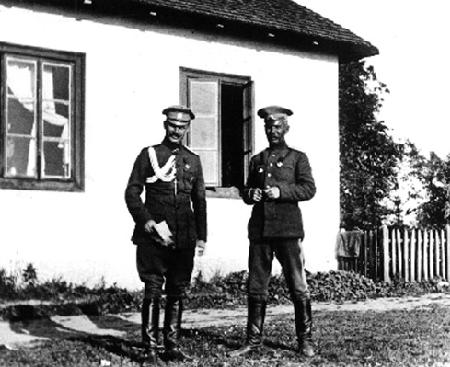

Mannerheim, who served in the Russian army, first commanded the Separate Cavalry Brigade of the Guard, consisting of the Uhlan Regiment of Life Guard, the Grodno Hussar Regiment and one artillery battery. The Brigade secured the manoeuvres of the 4th army in the area of Lublin, taking part in the battles of Krasnik, Gostseradov, Annopolis, Opole, the River Hodel and Zagrody-Nezluv, and was repelling the Austrian attack against Lublin in the ranks of the Guard Corps and chasing the Austrians during the great battle of Galicia, on this occasion participating in the battles of Zhlokievka, Tarnavka, Janov and Pikule-Momonta. In September 1914, the brigade was engaged in the protection of the manoeuvres of the army near the town of Opatov on the River Vistula in the ranks of Genral Delsal’s detachment, participating in the battle of Sloptov-Klimonotvi.
Mannerheim proved to be a brave leader. Serving in the ranks of the 4th Army in 1914, his actions in the defence battle of Krasnik earned him the Sword of St George. A little later he was awarded the Cross of St George.
In October and November 1914, Mannerheim’s brigade participated, in the ranks of the 9th Army, in the battles of Ivangorod, Tsharnyjlas-Zvolja, Politshna, Zvolen, Kutshk, Gezin, Leshtshiny, Komork, Piotrkovits, Pintshov, Hraberzh, Pomovits, Vavrzhentshits and Krakov.
From 18 February, 1915, Mannerheim commanded the 12th Cavalry Division, consisting of Ahtyr Hussar Regiment, Belgorod Uhlan Regiment, Starodubov Dragoon Regiment, Orenburg Cossack Regiment, and some Don and Turkestan mountain batteries. He distinguished in the battle of Opolje in August and September 1915, and served as the acting commander of the second Cavalry Corps on several occasions in 1915. During the defensive battle the division was stationed in Fundul-Moldav in May and June 1917. Witnessing the destruction and ravage caused by a great war brought about a change in Mannerheim. From an indifferent cavalry officer, he developed into an operational leader, concerned about saving the lives of the men.
Mannerheim commanded a large Russo-Rumanian group Wrancza on the Rumanian front in the Carpathian Mountains from 11 December, 1916, till 7 January, 1917. At the outset, the troop included the 12th Cavalry Division and a Rumanian infantry brigade, and later two Russian cavalry divisions, two and a half Rumanian infantry divisions and four Rumanian cavalry regiments. The troop defended a front line, 55 verst in breadth, on theTranssylvanian Carpathians and participated in six battles.
Mannerheim was appointed commander of the 6th Cavalry Corps on the 12th of June 1917, and participated in its ranks, in the battles on the Rumanian front in July and August, 1917. He resigned from this post on grounds of his health on the 8th of September, 1917, and on 20 September he was transferred into the reserve of the Odessa military district "as unadaptable to present conditions".
Military Ranks | Military Career in Russia | Russian Army | Imperial Guard | Administration of Imperial Stables | Nicholas II | In Russo-Japanese War | Chinese Expedition 1906-1908 | Scientific Expedition in Asia | Time in Poland | World War I | Mannerheim in World War I | Cross of St George | Sword of St George | Russian Revolution | Resignation from Russian Service
COURSE OF LIFE | FAMILY | TIME OF GROWTH | MILITARY CAREER | WAR OF INDEPENDENCE | REGENT 1918-1919 | CIVILIAN | DEFENCE COUNCIL | COMMANDER-IN-CHIEF 1939-1946 | PRESIDENT OF THE REPUBLIC 1944-1946 | RETIREMENT | SPECIAL TOPICS | SEARCH

